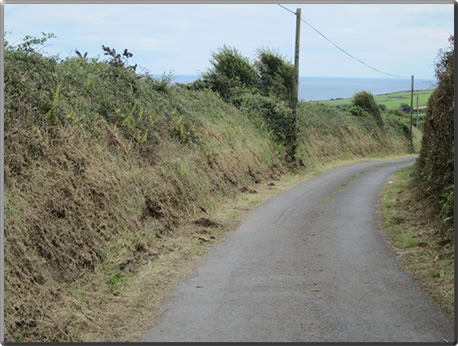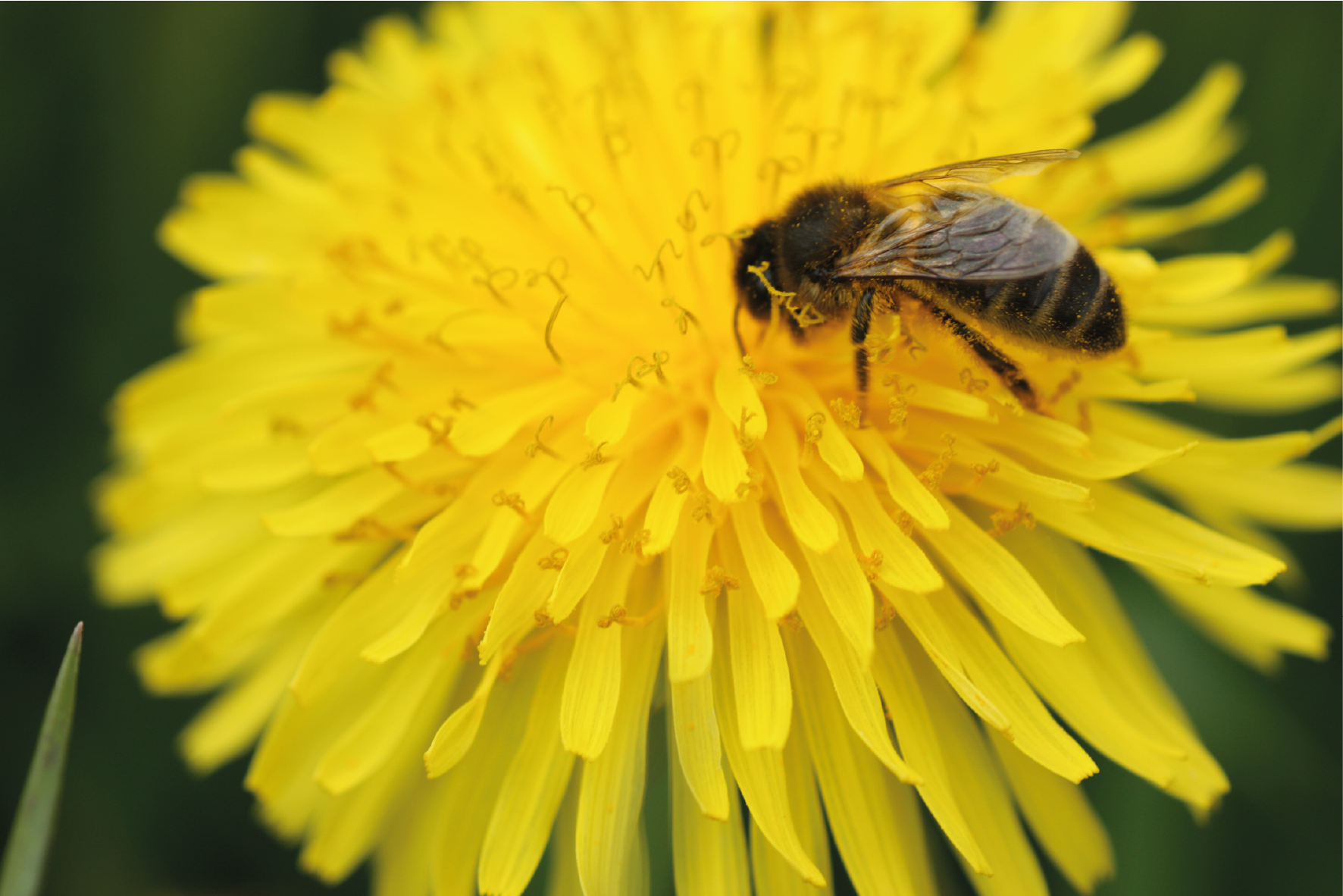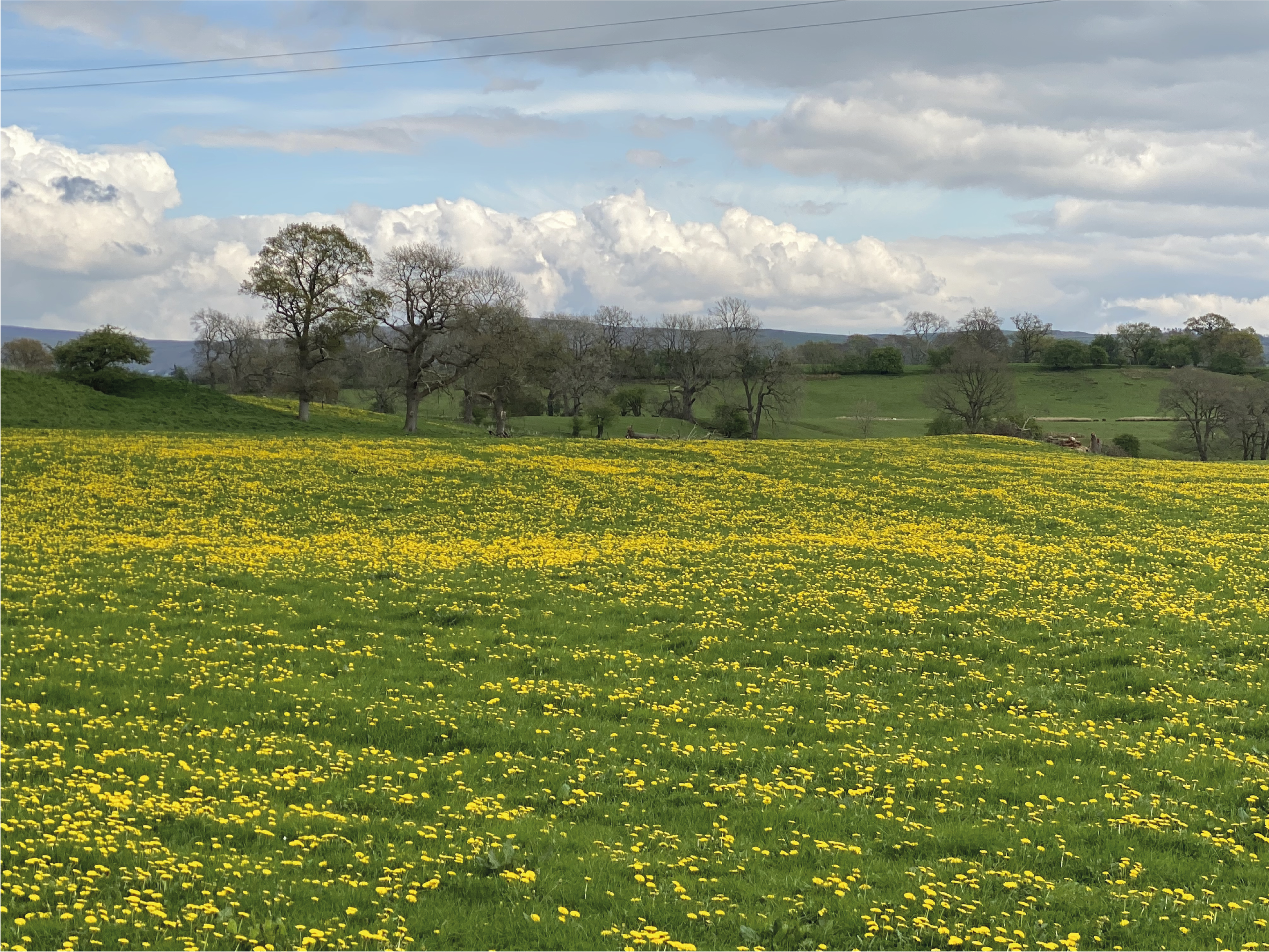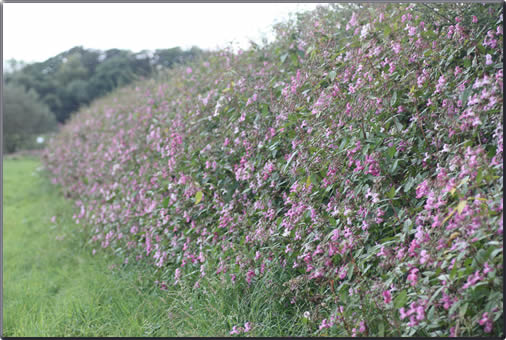Honey 2
Forage and Agricultural Practice
The Forest of Bowland lying south of the Lake District is one of the wettest areas in England. As such farming is concerned mainly with sheep and cattle. There are very few arable crops grown in this area. The fields appear as green deserts with little evidence that farmers are aware that clover is a nitrogenous fertilizer.
The climate is too wet for oilseed rape so the bees have little to forage in the open green fields.
The area, however, is rich in hedgerows and trees. The hedges provide a plentiful supply of nectar from the hawthorn and bramble and wild flowers which grow along the hedge bottom.
The photo on the left, for example, shows the profusion of Himalayan balsam in late summer along a hedge close to the River Ribble. These flowers provide a rich bonanza for all bees at this time of the year.
Trees which supply a plentiful supply of nectar and pollen include fruit blossom, the sycamore in May and the lime in June
The climate is too wet for oilseed rape so the bees have little to forage in the open green fields.
The area, however, is rich in hedgerows and trees. The hedges provide a plentiful supply of nectar from the hawthorn and bramble and wild flowers which grow along the hedge bottom.
The photo on the left, for example, shows the profusion of Himalayan balsam in late summer along a hedge close to the River Ribble. These flowers provide a rich bonanza for all bees at this time of the year.
Trees which supply a plentiful supply of nectar and pollen include fruit blossom, the sycamore in May and the lime in June
The photograph shows our nearest boreen after severe cutting by a local farmer in July (the Atlantic is in the distance). Place the cursor over the image to see something of the boreen before this cutting.
The photograph shows Himalayan balsam along a hedgerow close to the River Ribble in August 2018. The following year the farmer sprayed all his hedge bottoms with weed killer. Place the cursor over the image to see how this affected the balsam in August 2020 - very sad.
There is, however, some good news. The photo below shows a field near to Lower Hodder Bridge full of dandelions in the first week of May! and this is not the only field full of this nectar and pollen.
There is, however, some good news. The photo below shows a field near to Lower Hodder Bridge full of dandelions in the first week of May! and this is not the only field full of this nectar and pollen.


Protecting Hedges and Ditches in Ireland
When I was beekeeping in Ireland the agriculture was quite different. There the fields are surrounded by stone walls (ditches) and it is here that the bee found most of its nectar and pollen. The ditches over the centuries have become overgrown and are valuable wildlife resources, provide habitats for nesting birds, small mammals and countless insects including butterflies, moths, bumble and honey bees.
As well as these there are countless wild flowers growing on these ditches. Bramble being the main source of nectar in the summer for the honey bee. Trees and shrubs which are also valuable nectar and pollen sources include the sycamore, hawthorn, gorse and fuchsia.
With such a wildlife treasure along each road it might be expected that this would be appreciated for what it is in the summertime and the required cutting back only done in the autumn when everything has died back. But no. Some local farmers start this cutting back in July presumably to ensure that things look neat and tidy. The boreen shown on the left, for example, was a joy to behold until a severe 'skelping' took place in July.
When I was beekeeping in Ireland the agriculture was quite different. There the fields are surrounded by stone walls (ditches) and it is here that the bee found most of its nectar and pollen. The ditches over the centuries have become overgrown and are valuable wildlife resources, provide habitats for nesting birds, small mammals and countless insects including butterflies, moths, bumble and honey bees.
As well as these there are countless wild flowers growing on these ditches. Bramble being the main source of nectar in the summer for the honey bee. Trees and shrubs which are also valuable nectar and pollen sources include the sycamore, hawthorn, gorse and fuchsia.
With such a wildlife treasure along each road it might be expected that this would be appreciated for what it is in the summertime and the required cutting back only done in the autumn when everything has died back. But no. Some local farmers start this cutting back in July presumably to ensure that things look neat and tidy. The boreen shown on the left, for example, was a joy to behold until a severe 'skelping' took place in July.
It might be noted that in Ireland the Wildlife (Amendment) Act, 2000 protects hedgerows and section 46 of the Act updates Section 40 of the 1976 Act to provide an increased protection period for them. To quote:
"It shall be an offence for a person to cut, grub, burn or otherwise destroy, during the period beginning on the 1st day of March and ending on the 31st day of August in any year, any vegetation growing on any land not then cultivated." and "It shall be an offence for any person to cut, grub, burn or otherwise destroy any vegetation growing in any hedge or ditch during the period mentioned [above]".
"It shall be an offence for a person to cut, grub, burn or otherwise destroy, during the period beginning on the 1st day of March and ending on the 31st day of August in any year, any vegetation growing on any land not then cultivated." and "It shall be an offence for any person to cut, grub, burn or otherwise destroy any vegetation growing in any hedge or ditch during the period mentioned [above]".

